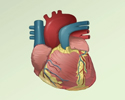Exercise and activity - children
Children should have many chances to play, run, bike, and play sports during the day. They should get at least 60 minutes of moderate activity every day.
Moderate activity makes your breathing and heartbeat speed up. Some examples are:
- Walking fast
- Playing chase or tag
- Playing basketball and most other organized sports (such as soccer, swimming, and dancing)
Younger children cannot stick with the same activity as long as an older child. They may be active at one activity for only 10 to 15 minutes at a time. The goal is still to get at least 60 minutes of total activity every day.
Why Exercise?
Children who exercise:
- Feel better about themselves
- Are more physically fit
- Have more energy
Other benefits of exercise for children are:
- A lower risk for heart disease and diabetes
Heart disease
Coronary heart disease is a narrowing of the blood vessels that supply blood and oxygen to the heart. Coronary heart disease (CHD) is also called co...
 ImageRead Article Now Book Mark Article
ImageRead Article Now Book Mark ArticleDiabetes
Diabetes is a long-term (chronic) disease in which the body cannot regulate the amount of sugar in the blood.
 ImageRead Article Now Book Mark Article
ImageRead Article Now Book Mark Article - Healthy bone and muscle growth
- Staying at a healthy weight
Healthy weight
When children eat more than they need, their bodies store the extra calories in fat cells to use for energy later. If their bodies do not need this ...
 ImageRead Article Now Book Mark Article
ImageRead Article Now Book Mark Article
Getting Started
Some kids enjoy being outside and active. Others would rather stay inside and play video games or watch TV. If your child does not like sports or physical activity, look for ways to motivate them. These ideas may help children become more active.
- Let children know that being active will give them more energy, make their bodies stronger, and make them feel better about themselves.
- Give encouragement for physical activity and help children believe they can do it.
- Be their role model. Start being more active if you are not already active yourself.
Start being more active
Experts recommend getting at least 30 minutes of moderate exercise most days of the week with a target of 150 minutes per week. If you have a busy s...
 ImageRead Article Now Book Mark Article
ImageRead Article Now Book Mark Article - Make walking a part of your family's daily routine. Get good walking shoes and rain jackets for the wet days. Do not let rain stop you.
Good walking shoes
When exercising, what you wear can be just as important as what you do. Having the right footwear and clothing for your sport can give you both comf...
Read Article Now Book Mark Article - Go for walks together after dinner, before turning on the TV or playing computer games.
- Take your family to community centers or parks where there are playgrounds, ball fields, basketball courts, and walking paths. It is easier to be active when people around you are active.
- Encourage indoor activities such as dancing to your child's favorite music.
Find a Good Match
Organized sports and daily activities are good ways for your child to get exercise. You will have better success if you select activities that fit your child's preferences and abilities.
- Individual activities include swimming, running, skiing, or biking.
- Group sports are another option, such as soccer, football, basketball, karate, or tennis.
- Choose an exercise that works well for your child's age. A 6-year-old may play outside with other kids, while a 16-year-old may prefer to run at a track.
Daily activities can use as much, or more, energy than some organized sports. Some everyday things your child can do to be active include:
- Walk or bike to school.
- Take the stairs instead of the elevator.
- Ride a bike with family or friends.
- Take the dog for a walk.
- Play outside. Shoot a basketball or kick and throw a ball around, for instance.
- Play in the water, at a local pool, in a water sprinkler, or splashing in puddles.
- Dance to music.
- Skate, ice-skate, skateboard, or roller-skate.
- Do household chores. Sweep, mop, vacuum, or load the dishwasher.
- Take a family walk or hike.
- Play computer games that involve moving your whole body.
- Rake leaves and jump in the piles before bagging them up.
- Mow the lawn.
- Weed the garden.
Reviewed By
Stefania Manetti, RDN, CDCES, RYT200, My Vita Sana LLC - Nourish and heal through food, San Jose, CA. Review provided by VeriMed Healthcare Network. Also reviewed by David C. Dugdale, MD, Medical Director, Brenda Conaway, Editorial Director, and the A.D.A.M. Editorial team.
Centers for Disease Control and Prevention website. Physical education and physical activity: Student physical education and physical activity. www.cdc.gov/physical-activity-education/about/index.html. Updated June 25, 2024. Accessed April 17, 2025.
Cooper DM, Bar-Yoseph R, Olin JT, Lovinsky-Desir S, Random-Aizik S. Exercise, physical activity, and respiratory health and disease in pediatrics. In: Bush A, Deterding R, Li AM, et al, eds. Kendig's and Wilmott's Disorders of the Respiratory Tract in Children. 10th ed. Philadelphia, PA: Elsevier; 2024:chap 12.
Gahagan S. Overweight and obesity. In: Kliegman RM, St. Geme JW, Blum NJ, et al, eds. Nelson Textbook of Pediatrics. 22nd ed. Philadelphia, PA: Elsevier; 2025:chap 65.
Disclaimer



 All rights reserved.
All rights reserved.